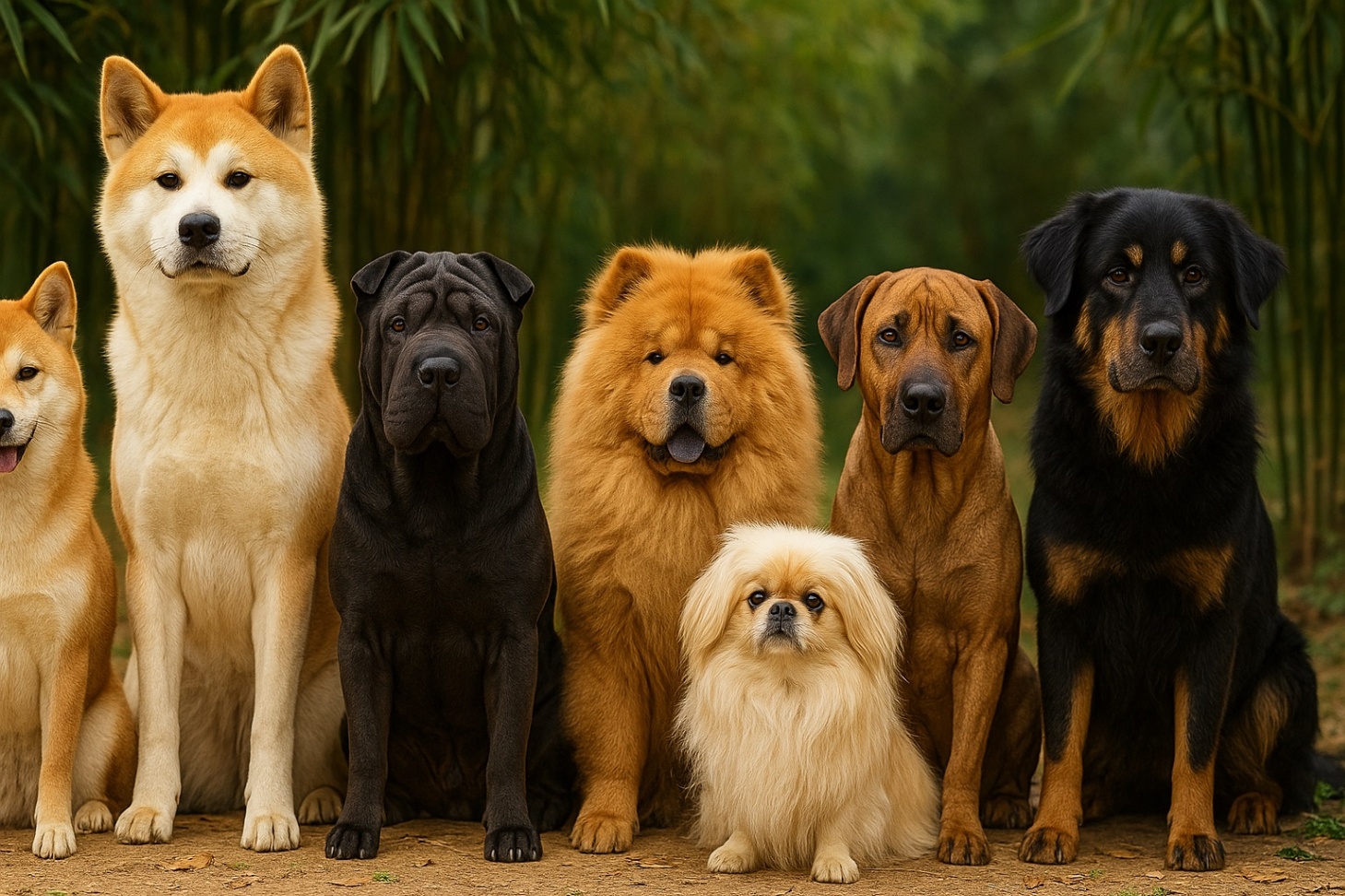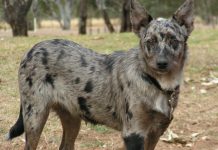When we think of dog breeds with Asian origins, names like the Shih Tzu, Akita, or Chow Chow often come to mind.
However, Asia—being the largest and most diverse continent—has contributed far more to the canine world than many realize.
From ancient desert guardians to mountain-dwelling companions, Asia’s influence on dog breeds spans centuries and regions.

1. Central Asian Shepherd Dog (Alabai)
The Alabai, originated in the Central Asian steppes, encompassing countries such as Turkmenistan, Uzbekistan, Kazakhstan, and parts of Afghanistan.
Historically bred by nomadic tribes, this breed was used to guard livestock against large predators like wolves and bears.
According to the Fédération Cynologique Internationale (FCI), the breed is over 4,000 years old.
Today, they are still used for protection in rural regions and have also been employed by militaries for their endurance and strength.
2. Kintamani-Bali Dog
Native to the island of Bali, Indonesia, the Kintamani-Bali Dog is a unique breed with a fox-like face and flowing fur.
Though not widely known outside Southeast Asia, this breed is considered the only official dog breed recognized by the Indonesian government.
Despite its relatively isolated development, the breed shares genetic similarities with ancient Asian dogs, particularly the Australian dingo and Asian pariah dogs.
Kintamanis are friendly, alert, and surprisingly agile. They make excellent family dogs and are increasingly seen in Indonesian homes.
3. Tibetan Spaniel
While it shares part of its name with the Cavalier King Charles Spaniel, the Tibetan Spaniel is a completely distinct breed, with no genetic relation to European spaniels.
Originating in the monasteries of Tibet, this small dog was bred not for hunting or herding but as a companion and spiritual guardian.
Buddhist monks highly valued Tibetan Spaniels for their keen eyesight and habit of sitting on monastery walls to watch over the surroundings.
It is one of the oldest companion breeds in Asia, dating back more than 2,500 years.
4. Bakharwal Dog
The Bakharwal Dog is a rare and ancient working breed from northern India, particularly in the Himalayan regions of Jammu and Kashmir.
Bred by the nomadic Gujjar tribes, Bakharwals have been used for herding and guarding livestock in harsh mountain terrains for centuries.
Unlike many modern breeds, Bakharwals are still primarily raised for utility rather than companionship.
Efforts are underway to conserve the breed, as modernization and regional conflict have led to a sharp decline in their population.
5. Tosa Inu (Tosa Ken)
Developed in the Tosa region during the 19th century, the breed is a mix of native Japanese dogs and European breeds like the Mastiff, Great Dane, and Bulldog.
Originally bred for dog fighting, the Tosa Inu is a quiet, stoic, and powerful breed. Tosas were trained to fight silently—a reflection of Japanese cultural ideals.
Despite its fighting past, modern Tosas are calm and reserved when properly trained.
They are banned or restricted in several countries due to their intimidating appearance and strength, but in Japan, they are still respected as national icons.
6. Thai Ridgeback
With a distinct ridge of hair growing in the opposite direction along its back, the Thai Ridgeback is both striking and ancient.
Believed to have originated in eastern Thailand over 300 years ago, this breed was used for hunting and guarding property in remote villages.
Due to geographic isolation, the Thai Ridgeback developed with minimal crossbreeding, preserving its natural instincts and unique physical traits.
The breed is muscular, athletic, and highly intelligent, but also independent, traits that make it a challenge for novice dog owners.
7. Phu Quoc Ridgeback
While the Thai Ridgeback is better known, its cousin, the Phu Quoc Ridgeback, is even rarer.
Native to Phu Quoc Island in Vietnam, this breed shares the signature ridge of hair but is smaller and more agile.
The Phu Quoc Ridgeback was traditionally used to hunt wild boar and guard homes, and it developed in relative isolation on the island.
Although not yet recognized by the American Kennel Club (AKC), it has received attention in Vietnam and among regional breed preservationists.

Comparison
Here is a comparison table highlighting key differences and similarities among the 7 dog breeds from Asia discussed in the article:
| Breed | Country of Origin | Main Purpose | Distinct Traits | Recognition Status |
|---|---|---|---|---|
| Central Asian Shepherd (Alabai) | Turkmenistan / Central Asia | Livestock guardian | Ancient breed; hardy and predator-resistant | FCI recognized |
| Kintamani-Bali Dog | Indonesia (Bali) | Companion, village dog | Indigenous to volcanic highlands; fox-like appearance | Indonesian government-recognized |
| Tibetan Spaniel | Tibet | Companion, spiritual guardian | Keen watchdog; associated with Tibetan monasteries | AKC and FCI recognized |
| Bakharwal Dog | India (Jammu & Kashmir) | Livestock guardian | Bred by nomadic Gujjars; endangered native breed | Recognized by Indian Kennel Club |
| Tosa Inu | Japan | Dog fighting, guard dog | Bred for silent fighting; muscular with mastiff traits | FCI recognized (special regulation) |
| Thai Ridgeback | Thailand | Guarding, hunting | Unique hair ridge; minimal crossbreeding | FCI recognized |
| Phu Quoc Ridgeback | Vietnam (Phu Quoc Island) | Hunting, guarding | Webbed feet; ridge on back; strong swimmer | Not officially recognized internationally |
- Size and Build: The Central Asian Shepherd and Tosa Inu are large to giant breeds, suited for protection and defense. The Tibetan Spaniel, in contrast, is a small, agile companion, while the Phu Quoc and Thai Ridgebacks are medium-sized, athletic hunters.
- Temperament: Breeds like the Alabai, Tosa, and Bakharwal show strong protective instincts, ideal for guarding. The Tibetan Spaniel is more sociable and affectionate, though still alert. Kintamani dogs are balanced, while the Ridgebacks are intelligent but may be independent and stubborn.
- Special Features: Hair Ridge; Present in Thai and Phu Quoc Ridgebacks. Ancient Lineage; The Alabai and Tibetan Spaniel have thousands of years of history. Geographic Isolation; Kintamani, Phu Quoc, and Thai Ridgebacks developed with minimal outside influence.
- Recognition: Most of these breeds are recognized by international or national kennel clubs, but the Phu Quoc Ridgeback is still awaiting broader recognition despite local conservation efforts.
Final Thoughts
Asia’s contribution to the dog world extends far beyond the well-known Shiba Inus or Pekingese.
From the volcanic highlands of Bali to the snowy plateaus of Central Asia, these breeds reflect the continent’s cultural, climatic, and geographic diversity.
Each dog tells a story—not only of its working history but of the people and environments that shaped it.




















